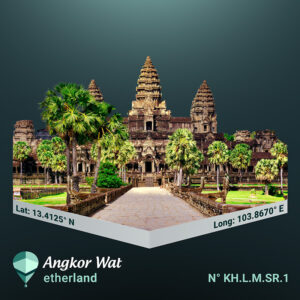 Built by the King Suryavarman II in the early 12th century, Angkor Wat is one of the largest religious monuments to have ever existed. Facing the west to symbolize the setting sun as death, its name stands for ‘Temple City’. The Temple is hauntingly beautiful and stands out thanks to its perfect composition, grand scale and preservation until this day.
Built by the King Suryavarman II in the early 12th century, Angkor Wat is one of the largest religious monuments to have ever existed. Facing the west to symbolize the setting sun as death, its name stands for ‘Temple City’. The Temple is hauntingly beautiful and stands out thanks to its perfect composition, grand scale and preservation until this day.
Located roughly five miles Northwest of the modern Cambodian city of Siem Reap, Angkor Wat is the largest religious structure in the form of a temple complex in the world by land area. It is an enormous Buddhist temple complex whose history dates back to the 12th century. Measuring 162.6 hectares (400 km2), it is the most important archeological site in South East Asia. In the large area, there are forests and Angkor Archeological Park.
Angkor Wat translates as the city of the temple in the local Khmer language, was originally a Hindu temple to worship the god Vishnu but turned into a Buddhist complex before the end of the 12th century. Initially, it was built by Emperor Suryavarman II, who ruled in this region from 1113 to 1150. This temple complex was built as a state temple and political center of his Empire. According to Buddhist legends, the order of the temple’s construction was given by the god Indra, and it was completed in one night.
In the archeological park, there are many remains of the Khmer Empire. At the center of the temple complex, there are five towers on a temple mountain and three rectangular galleries. The four towers are raised on four sides, with one central spire that overlooks the other towers with its 65-meter height. A wide moat surrounds the old and iconic temple complex, and it is beautified with intricate and delicate carvings. The temple is a cleverly harmonized architectural heaven built in a classical Khmer style. The extensive bas-reliefs and statues of Buddha and Devas are carved on its walls. The temple is designed to represent Mount Meru which holds significance in Buddhist cosmology, making it the most significant religious site where pilgrims from Cambodia and all around the world used to visit to pay their respect and homage.
The temple was lost to history when a rival tribe took over in the 15th century, and the capital was shifted to Angkor Thom. However, it was rediscovered by French explorer Henri Mouhot in 1840. Impressed by its grandeur and splendor, he famously said that “it is grander than anything left to us by Greece or Rome.” It has become a symbol of Cambodia as it appears on the country’s national flag, making it the country’s main tourist attraction. It is also believed that Angkor Wat played a significant role in attracting Buddhism and converting Cambodia into a Buddhist nation.
Other than the main temple complex of Angkor Wat, in the archeological park, there are other temples such as Angkor Thom and the Bayon Temple. Each of these temples has unique sculptural decorations that call visitors and tourists annually in huge numbers.
After the unrest in the country in the 1970s, Angkor Wat came under attack as well which left the site ruined and in need of reconstruction and rehabilitation. After finishing work in 1992, the temple was added to UNESCO World Heritage sites in Danger. With wide-ranging safeguard programs and restoration efforts, it was out of the danger list in 2004. Thousands of visitors visit the new and improved temple site every year.